How to grow clematis from seeds?

Growing clematis with seeds is not an easy task. This process is long and laborious, therefore summer residents and gardeners will have to work hard to achieve a positive result. But for real lovers of exquisite vines, nothing is impossible, therefore we will tell you about the rules for seed growing of clematis.
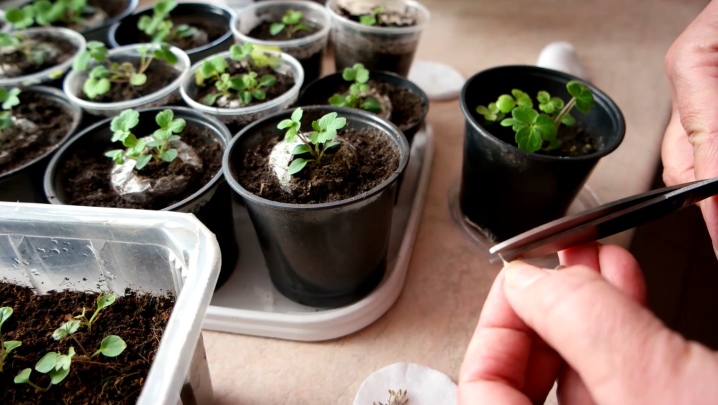
Which variety is right?
If you are fired up with the idea of obtaining clematis from seeds, you will have to seriously approach the process of choosing a variety suitable for breeding.
- For beginners who are just planning to learn all the secrets of growing clematis from seeds, better to start with the Manchu variety... These plants look more like bushes than vines. In summer, the shoots are covered with small white flowers that exude a pleasant aroma. Manchurian clematis is easy to care for and grow, so there are no problems with it.
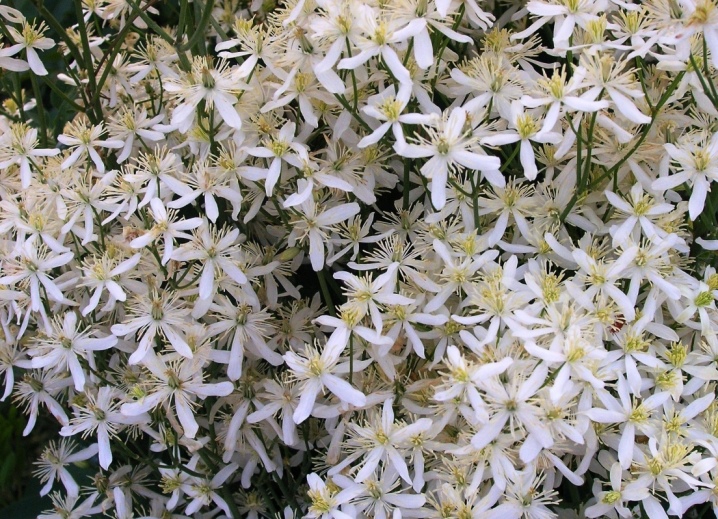
- "Arabella" - This is an unpretentious clematis, which belongs to late-flowering and large-flowered vines. Flowering will continue from May to September if the plant is in ideal conditions. Flowers reach 10 cm in diameter, are painted in a purple shade with gray notes. Throughout the season, the lilac color changes to blue, which makes the vine spectacular and expressive.

- "Blue Light" refers to early vines. Terry flowers, painted blue. Shoots with a length of about 2 meters cling well to the supports with the help of leaf petioles. This clematis blooms 2 times a year, well suited for growing in containers.
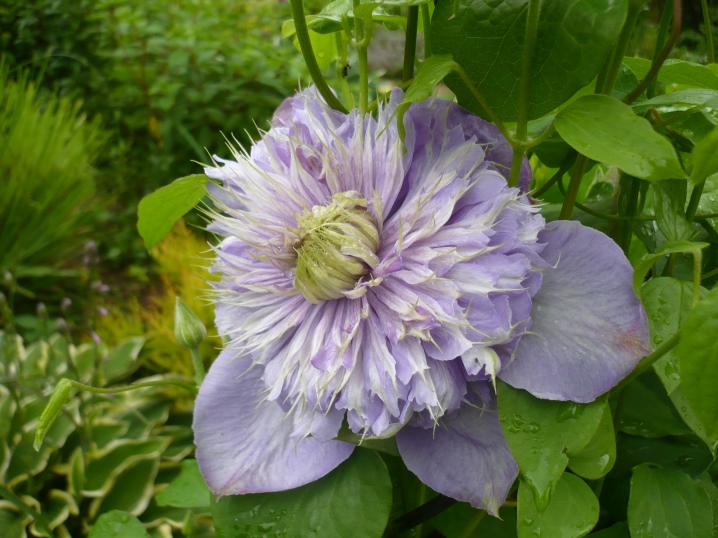
- "Blue Explosion" - the result of the work of Polish breeders. The liana is decorated with large blue flowers, in which pinkish notes can be traced. The diameter of the flower starts at 12 cm, and the length of the stems reaches 3 m. The flowering of this clematis can be enjoyed twice a year.

- "Westerplatte" is held in high esteem among gardeners, as evidenced by numerous positive reviews. This variety also originated in Poland. The stems grow up to 2 meters, they are decorated with sparkling, red, large flowers.
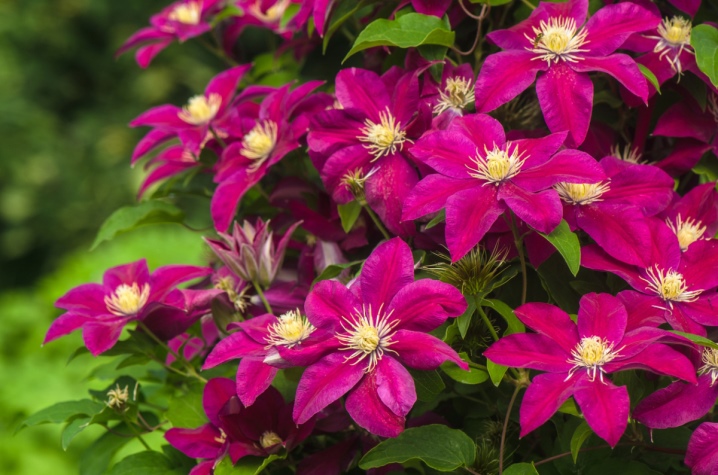
- "Helios" with proper seed cultivation, it can give good results. The seeds can be bought at a specialty store or even harvested by yourself. Clematis of this variety is a vigorous plant with stems up to 3 m high. From June to August, the liana is decorated with a scattering of small yellow flowers that have an inverted shape.
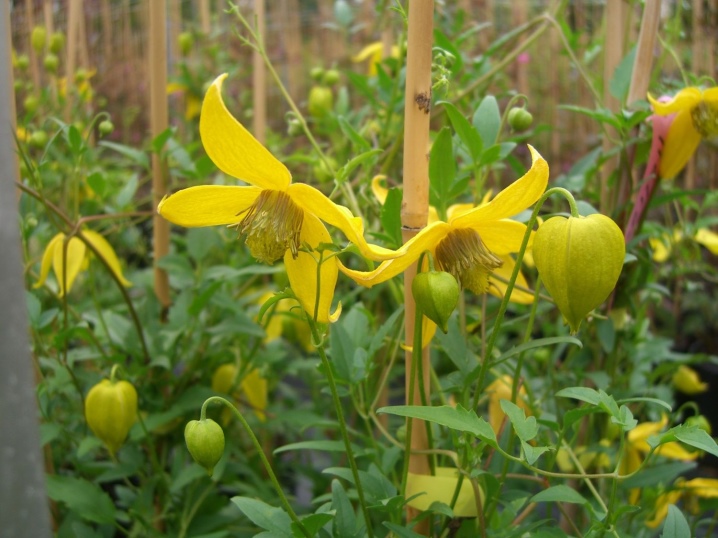
- "Daches Eydinburg" blooms early, releasing large terry flowers of snow-white color in the shape of a ball. The stems grow up to 3 m.

- "Dr. Ruppel" is the most original variety from our selection. The color of large flowers changes depending on the lighting: there is a fuchsia-colored stripe on a pink background, or a lavender flower is decorated with a pink stripe. Liana blooms twice a year.

- "Cloudburst" Is a late variety with large flowers. It was recently bred by Polish breeders. Shoots grow up to 2.5 meters in length, they are decorated with flowers with a pink-purple color, a white center and pink veins. The petals are diamond-shaped, wavy, sharp edges.

- Comtesse de Boucher it blooms late, is considered a strong crop, the shoots of which grow up to 4 m. Pink flowers appear twice a year.

- Clematis Long Fire really resembles fire due to bright colors, which reach 16 cm in diameter.Although re-flowering is not typical for this plant, this clematis already produces many flowers that completely cover the vine. The height of the stems does not exceed 1.5 m.

- "Omoshiro" is originally from Japan. It blooms twice a year, three-meter stems are covered with large snow-white or delicate pink flowers.

- "Change of Hart" - This is a strong clematis with two-meter stems, which are covered with red flowers with a purple tint 2 times a year. The diameter of the flowers starts from 10 cm.

- "Etual Violet" fell in love with gardeners for its unpretentiousness, abundant flowering, spectacular purple flowers and the possibility of seed reproduction.
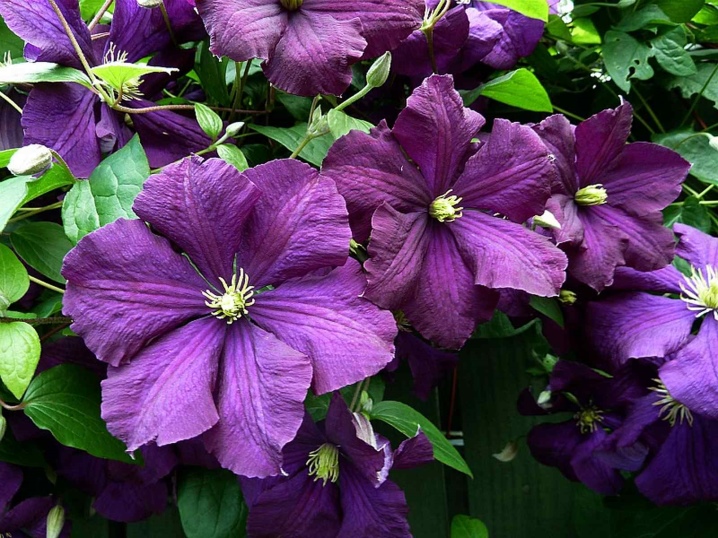
We strongly recommend using the seed of these particular clematis, especially if this is the first experience. With these varieties, the chances of success increase.
Seed preparation
For the propagation of clematis by seeds to be successful, it is necessary to seriously approach the process of preparing the seed material. Every nuance is important here, so you need to strictly adhere to the rules.
- If the seeds will be bought in a specialty store, then this step can be skipped. Self-procurement of planting material is not as easy as it might seem. Procurement of seeds for different types of creepers can occur at different times of the year. Here, the individual characteristics of the plant are taken into account. Moreover, different seeds can form on the same vine. They can look different and vary in size. It is not enough to collect the seeds, they still need to be sorted correctly. The largest and most beautiful specimens are selected, which do not have the slightest flaw.
- Stratification is a mandatory step. The result of this procedure will be an increase in the germination of the seed and the formation for it of resistance to the effects of pathogens. When sowing seeds in early spring, it will be enough to provide special conditions for their storage. It should be a dark room with a temperature of about 5 degrees. When sowing in the fall, the seeds must be kept in the refrigerator for at least 2 weeks, maximum 3. Such conditions will be as close as possible to those in which the seeds are found when they enter the soil on their own.
- Sparging also allows you to increase the germination of the seed, respectively, increases the chances of success. For bubbling, it is necessary to prepare a 0.5 liter jar and fill it with a solution of baking soda (for 250 ml of water, 1 tsp of soda). We immerse the seeds in a jar and have the most common aquarium compressor. With the compressor turned on, the seeds should spend at least 6 hours. Every 6-7 hours we change the water in the jar and continue bubbling in this mode for 4 days.

These processes are the essence of preparing seeds for further manipulations. As you can see, in order to propagate clematis using seeds, you will have to work hard.
How and where to sow?
Vine seeds can be planted in spring or autumn. The first option involves sowing seed directly into open ground. At home, seeds are planted for seedlings in the fall. This option is more difficult, but more effective. For autumn sowing, it is more convenient to use boxes, which, with the arrival of heat, can be easily taken out into the street and brought back into the room or placed in a greenhouse before planting in the ground.


The seeds need a nutrient mixture, only in this case they will turn into strong sprouts, which can be planted outside in spring. Step-by-step instructions for growing clematis from seeds begin with preparing a nutrient mixture. It should consist of the following components:
high-quality humus;
fine, preferably river sand;
Earth;
wood ash.
Sowing is desirable to carry out in a steamed mixture, which will ensure the absence of pathogens and other pathogens.

The seeds go deeper into the soil mixture to a depth that will be 2 times their size. To speed up the sprouting process, you can pour a little sand on top of the seeds. Many experts use this trick. There is no need to compact the soil, as this will complicate the admission of air to the seed, and it may disappear without showing itself in all its glory.
From the moment the seeds are planted in the ground to their germination, it can take from 21 days to 3 months. In some cases, it is necessary to wait for seedlings up to six months. This difference in germination time depends on the seeds and plant variety, as well as on the conditions of their maintenance. Stagnation of water in a container with future clematis should not be allowed in any way. The soil should be moist, but never wet. In this case, the seeds will not sprout, the cultivation will not be successful, and your efforts will be wasted.

Features of the pick
When the seedlings have acquired two real leaves, it is necessary to pick. Some gardeners recommend waiting for the fourth leaf. We do not recommend doing this, because in this case it will be more difficult for the sprouts to get used to the new conditions and take root, therefore, they recover for a long time, they can hurt and be weakened. A distance of up to 20 cm should be left between the seedlings, but not less than 15 cm. Such plants can be planted outdoors in a permanent place.
Here you need to focus on the weather conditions of a particular region. Cold and humid weather is not suitable for planting clematis outside. In this case, it is better to overexpose the seedlings in the greenhouse. At the same time, the sprouts need moderate watering, protection from drafts and direct sun. As soon as the weather outside normalizes, the soil warms up enough, and the night temperature becomes relatively high, the seedlings can be planted in a permanent place.

Open ground planting rules
Seedlings, which started growing from seed in the fall, are ready for transplanting outdoors in mid-spring. No one will name the exact date, since everything depends on weather conditions, night and day temperatures. If the seeds were planted in the nutrient mixture in the spring, then it will be possible to plant the sprouts in a permanent place only in the fall. Only some varieties can be kept until spring, for example, Clematis "Lomonos".
The choice of a place for planting seedlings is important. If mistakes are made, then the plant will not be able to develop normally and sooner or later will die, and not please with a beautiful flowering.

Despite the wide variety of varieties, it is preferable to plant clematis in places that meet a number of requirements:
deep bedding of groundwater, otherwise you will have to organize high-quality drainage, but it is better to abandon this place and think about another location of the garden culture;
although clematis is a light-loving plant, its roots should be in the shade;
drafts are one of the main enemies of the graceful liana, therefore you need to plant the shoots in a quiet place, protected from the winds;
the support for the plant must be thought out in advance: will it be natural (trees, bushes) or artificial (fence, arch).
Planting clematis sprouts is carried out according to the following rules:
make a hole up to 80 cm deep;
we place bricks, sand, expanded clay at the bottom for high-quality drainage;
lower the seedling, gently straighten the roots;
we fill the voids with high-quality fertile soil in such a way that the sprout is deepened by 10 cm to the first bud, and not just to the root collar;
leave a distance of up to 10 cm to the edges of the pit;
Water the clematis abundantly and mulch it with peat.

Observing such simple rules, you can easily grow clematis from seeds. Although this process is long and difficult, every gardener and lover of beautiful flowering plants can do it.
Care Tips
Taking care of a young clematis is not difficult, therefore even a novice gardener can handle this work. Our tips for caring for a seed-grown vine will help in this matter:
it will be necessary to add earth to the root collar, depending on the growth of the plant;
for a more active formation of new shoots, it is necessary to regularly cut off the tops of the vines;
watering clematis should be regular, basal, but not plentiful, since clematis does not like high humidity and does not tolerate water well on foliage;
clematis needs fertilizers, therefore, after planting, it is recommended to add urea at the rate of 1 teaspoon per bucket of water, then a mullein (1: 20) or a special complex of mineral fertilizers is used;
a young plant definitely needs shelter, therefore, for the winter period it must be protected from frost with burlap, needles, special material or roofing material.
How to grow clematis from seeds, see below.







































































































The comment was sent successfully.